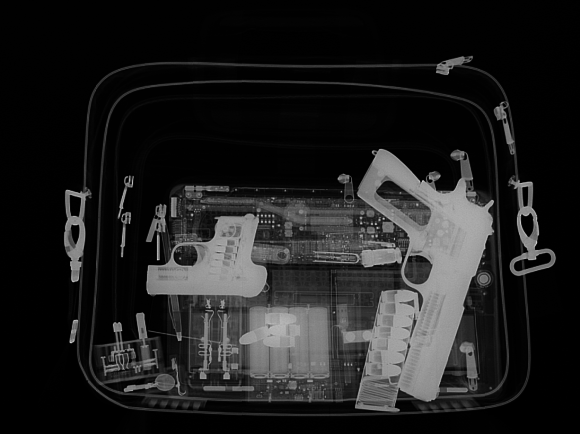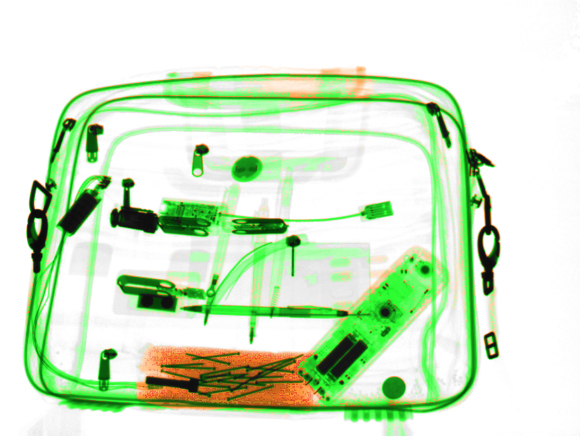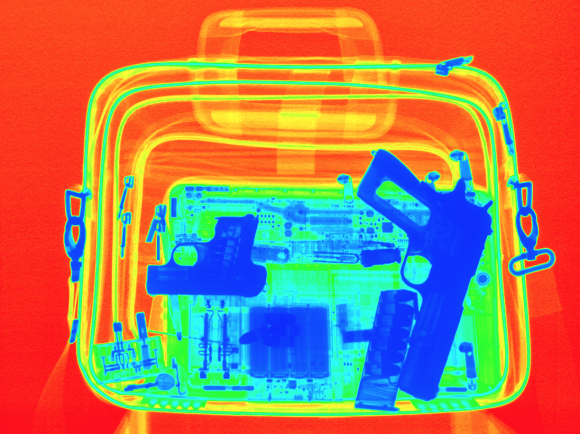At least once in our lifetime, we all have had a quick puzzled look at the computer screen, when going through the security check at the airport, and wondered about the complexity of the image that was showing on the screen.
Indeed, seeing this type of image does not always make sense to the untrained eye. It takes weeks of practice before being able to distinguish between a TNT bomb… and a toothpaste tube.
First, you should know that mainly two types of x-ray images can be obtained when screening an object.
The most common one is the image you get when taking a dental x-ray, which shows many types of greys and blacks. The other one is the one you see when getting screened at security checks at the airports, which is usually as colorful as rainbows.
Analyzing and interpreting an x-ray image can be a very quick and accurate process if you know what you are looking for. Indeed professionals such as EOD (Explosive Ordnance Disposal) experts and border control agents can spot a gun, knife, or an improvised bomb in a few seconds. If you want to be (almost) as effective as these professionals are, all you need to do is observe various x-ray images of those items at different angles, and you will be field-ready in a matter of weeks.
The trickiest part of the x-ray interpretation comes up when you get colored images to analyze. Indeed, all these colors can be quite confusing at first, but a small guide will quickly help you interpret what they mean.
Even though the colors might change depending on the x-ray scanner manufacturer, the underlining principles stay the same.
Let us take Teledyne ICM’s FLATSCAN software for instance. The black and white images (Fig. 1) are very sharp and interpreting those images does not require much training. Indeed, the guns, the bullets, and the computer are easily recognizable.

Now, have a look at the first colored image (Fig.2), also obtained with the FLATSCAN technology. According to you, what do the green outlines and the orange patches represent?

You might be aware that explosives are often partly composed of organic compounds such as glycerin, C4, and TNT. Moreover, drugs such as heroin, cocaine, and cannabis are also all organic products. Therefore, being able to detect what is natural and what is not, is critical for EOD, custom and police agents.
As you might have guessed by now, the orange patches on the image are organic materials, while the green zones represent non-organic compounds. By seeing organic material surrounding with what looks like nails, you might conclude that this particular bag is probably carrying some kind of bomb.
Now, go back to the first image and add a little color… (Fig. 3)

Here you can see different parts of the image in blue, green, and red tones.
First hand, you should know that x-rays highlight the difference in density of various materials. The bluer, the denser – the redder, the lighter.
The blue color always indicates that the x-ray “recognizes” this material as being very dense, thus being either some kind of metal, hard plastic or alloy. On this particular picture, the gun and the bullets are all dark blue, clearly suggesting that the pistol is genuine.
The green color on the other hand usually means plastic! Indeed, with this example, we are looking at a green square with little areas of blue in it. Plastic and metal usually refer to some kind of electronic device. By analyzing the shape of the object, we can conclude that the screened object is certainly a laptop or a tablet.
Finally, the red zone indicates that the x-ray beam has encountered very little or no resistance when penetrating the object, meaning that the object might be made out of some kind of fabric or another very light material such as carton or paper.
There you have it! The x-ray 101 guide to help you decipher the x-ray images you can get from taking a medical exam… or scanning a potential hazardous item.
